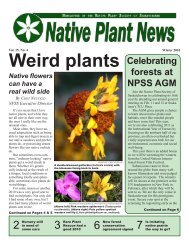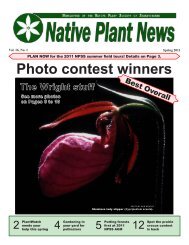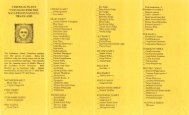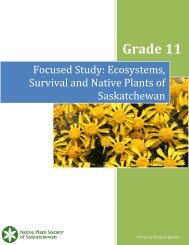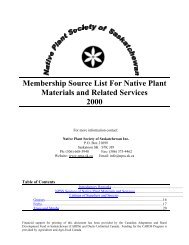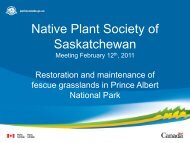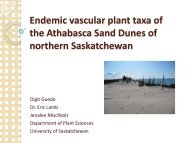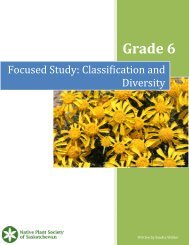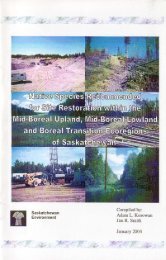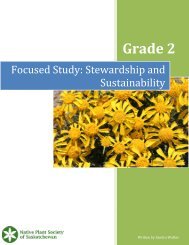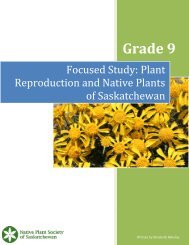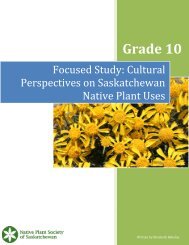Grade 10 Nutrient Cycling Lesson Plan - Native Plant Society of ...
Grade 10 Nutrient Cycling Lesson Plan - Native Plant Society of ...
Grade 10 Nutrient Cycling Lesson Plan - Native Plant Society of ...
Create successful ePaper yourself
Turn your PDF publications into a flip-book with our unique Google optimized e-Paper software.
<strong>Grade</strong> <strong>10</strong>Focused Study: <strong>Nutrient</strong> <strong>Cycling</strong>and <strong>Native</strong> <strong>Plan</strong>ts <strong>of</strong>SaskatchewanWritten by Elizabeth Bekolay
FOCUSED STUDY: NUTRIENT CYCLING AND NATIVE PLANTS OF SASKATCHEWANGRADE <strong>10</strong>“WHAT GOES AROUND COMES AROUND”OVERVIEW AND PURPOSETo explore and form an understanding <strong>of</strong> the unseen forces that keep everything on planet earth alive.The air that we and all other oxygen dependant life forms breath, the energy and elements that areessential for the survival <strong>of</strong> all, and the stories that we tell about these mysteries that only deepen asknowledge is shared between cultures.The students will study a local native legume in its habitat and create a piece <strong>of</strong> art that shows thecycling <strong>of</strong> nutrients and energy through the ecosystem.By focusing on one plant at a time, a relationship can be built between the student and the plant. AsJohn Muir wrote, ‘When one tugs at a single thing in nature, he finds it attached to the rest <strong>of</strong> theworld.’ When a child can focus on something in nature, something tangible that holds a story, and anadult helps to illuminate that story by asking more questions, the child can begin to see the connectionson their own as a revelation <strong>of</strong> their own exploration. This is the beginning <strong>of</strong> ecological literacy.OUTCOMES AND INDICATORSSE4 Identify cycles, change, and stability in ecosystems.Learning Objectives :1. Illustrate the cycling <strong>of</strong> nutrients and matter through biotic and abiotic components <strong>of</strong> an ecosystemby tracking carbon, nitrogen, and oxygen.3. Identify and respect various cultural perspectives on the cycling <strong>of</strong> nutrients and matter through theenvironment.MATERIALSThe internet. Pens, pencils, paper. <strong>Plan</strong>t identification books. A camera.Free publications from the <strong>Native</strong> <strong>Plan</strong>t <strong>Society</strong> <strong>of</strong> Saskatchewan:<strong>Native</strong> <strong>Plan</strong>ts, Water and Us!<strong>Native</strong> <strong>Plan</strong>t Communities <strong>of</strong> Saskatchewan Poster<strong>Native</strong> <strong>Plan</strong>t Communities <strong>of</strong> Saskatchewan PlacematSaskatchewan’s <strong>Native</strong> Prairie: Taking Stock <strong>of</strong> a Vanishing Ecosystem and Dwindling Resource.INTRODUCTIONBy this grade level a student should have a basic understanding <strong>of</strong> what a native plant is. However, it isalways good to reinforce and remind. A plant native or indigenous to Saskatchewan is one that hasevolved here. This means that it was here prior to European contact. <strong>Native</strong> plants are adapted to theirspecific climatic zone and soil type. There are both native aquatic plants and terrestrial plants. <strong>Plan</strong>tsthat are not native are considered ‘introduced’ or ‘exotic’. If these introduced species spread rapidlyand out-compete other plants in an ecosystem they are considered ‘invasive’ or sometimes referred toas ‘noxious weeds’. <strong>Native</strong> plants are part <strong>of</strong> the biodiversity that help to keep our ecosystems healthy.They support a vast number <strong>of</strong> species that have evolved with them in an intricate relationship. The loss
<strong>of</strong> this biodiversity has an impact throughout the ecosystem resulting in species endangerment andextinction. It is important to promote a sense <strong>of</strong> respect through ecological knowledge <strong>of</strong> place.Legumes are an important part <strong>of</strong> the nitrogen cycle. They are plants in the family Fabaceae thatproduce a carpel, or pod, that opens along both sides. Familiar examples <strong>of</strong> legumes are beans, peas,lentils, and clover. These are all introduced plants, brought here for agricultural use.Before beginning the study review the N, C, O and H 2 0 cycles. When in the field, show examples <strong>of</strong>different phases <strong>of</strong> N and C.How do plants and bacteria work together to take N gas from the air and put it in the soil as food?The root nodules show a pink colour whenthey are infected with nitrogen fixingbacteria Rhizobium. Photo by Ninjatacoshell.
Image: Johann Dréo modified by RaekyINSTRUCTIONAL METHODSThere is no better way to teach about nutrient cycles than by visitinga healthy functioning ecosystem. This may be more challenging forsome people in Saskatchewan, particularly in the south, where vastecosystems have been changed by human habitation.The cycles <strong>of</strong> the elementsare truly magical andconstant miracles.Everything is dependent onthe life or cycle stages <strong>of</strong>everything else.Bring your students to a local native ecosystem. In groups have themexplore the area, write a description and make a sketch <strong>of</strong> the habitat,list all the plants and animals they see and choose one legume to studyin-depth (review the characteristics <strong>of</strong> a legume before heading out).Make a sketch <strong>of</strong> the plant and take many pictures. Have them look atWhat does indigenousknowledge tell us about theearth forces that areunseen?every detail in order to help them identify it later. Or you can help them identify their plant on site ifyou bring an expert or native plant guides with you. The <strong>Native</strong> <strong>Plan</strong>t <strong>Society</strong> <strong>of</strong> Saskatchewan can helpyou to identify your species (see below). Make detailed notes <strong>of</strong> all the other species in the area tobegin to form an understanding <strong>of</strong> all the contributors to the carbon, nitrogen and oxygen cycles.Knowing which ecozone you are studying will really help to narrow the possibilities <strong>of</strong> species in thesearch for your plant’s identity.
http://esask.uregina.ca/entry/ecozones_and_ecoregions.htmlFind your ecozone. Are you inthe Prairie, Boreal Plain, BorealShield or Taiga Shield ecozone?Locate your ecoregion tonarrow your plant ID search.
Assignment:Once their plant is properly identified ask your students to write a story, poem or essay to accompany aposter or diagram <strong>of</strong> the carbon, nitrogen, oxygen and water cycles based on the legume and its habitat.Try to incorporate the energy that drives these forces – solar radiation. Follow the inquiry questionsbelow to aid in the study.INQUIRYExplore, observe, investigate, acknowledge sources, interpret, plan, and create.Questions: (These are not the essential questions to be answered; they are to help the teacher andstudents to explore the possibilities <strong>of</strong> what can be learned about their plant).Is the legume you studied a native plant? (white and yellow sweet clover, red clover, alfalfa and anyother crop species are not native).How prevalent are legumes in this habitat?Is this plant dry loving, sun loving, or moist and shade loving? Which animals might use this plant?How?What other creatures did you see near this plant? What other roles could this plant have in theecosystem?What role does this plant play in the N cycle? The C cycle? The O cycle?What is the role <strong>of</strong> solar energy in these cycles?How do other cultures view these plants and the elemental systems and cycles?ASSESSMENTHave the students share their research with each other in small groups. Invite community members tobe involved in the presentations. Display the student research in a location where other students fromyour school can learn from it.RESOURCESBooks:Aikenhead, G. and H. Michell. 2011. Bridging Cultures: Indigenous and Scientific Ways <strong>of</strong> KnowingNature. Pearson Canada. Toronto.Grant, T. and Littlejohn, G. 20<strong>10</strong>. Greening School Grounds: Creating Habitats for Learning. New<strong>Society</strong> Publishers. Gabriola Island.Kershaw, L. 2003. Saskatchewan Wayside Wildflowers. Lone Pine Publishing. Edmonton.
Hammermeister, A., D. Gauthier and K. McGovern. 2001. Saskatchewan’s <strong>Native</strong> Prairie: Taking Stock<strong>of</strong> a Vanishing Ecosystem and Dwindling Resource. <strong>Native</strong> <strong>Plan</strong>t <strong>Society</strong> <strong>of</strong> Saskatchewan. Saskatoon.Johnson, D., L. Kershaw, A. MacKinnon, and J. Pojar. 1995. <strong>Plan</strong>ts <strong>of</strong> the Western Forest: Alberta,Saskatchewan & Manitoba Boreal Forest & Aspen Parkland. Lone Pine Publishing and the CanadianForest Service. Edmonton.Keane, K. and D. Howarth. 2003. The Standing People: Field Guide <strong>of</strong> Medicinal <strong>Plan</strong>ts <strong>of</strong> the PrairieProvinces. Root Woman and Dave. Saskatoon.Savage, C. 2011. Prairie: A Natural History. Greystone Books. Vancouver.Wruck, G. and K. Gerein. 2003. <strong>Native</strong> <strong>Plan</strong>ts, Water and Us! <strong>Native</strong> <strong>Plan</strong>t <strong>Society</strong> <strong>of</strong> Saskatchewan.Saskatoon.Websites:Center for Ecoliteracyhttp://www.ecoliteracy.org/essays/systems-thinkingThe <strong>Native</strong> <strong>Plan</strong>t <strong>Society</strong> <strong>of</strong> Saskatchewanhttp://www.npss.sk.ca/University <strong>of</strong> Saskatchewan Herbarium Rare <strong>Plan</strong>ts Indexhttp://www.usask.ca/biology/rareplants_sk/root/htm/en/index.php/References:Johnson, D., L. Kershaw, A. MacKinnon, and J. Pojar. 1995. <strong>Plan</strong>ts <strong>of</strong> the Western Forest: Alberta,Saskatchewan & Manitoba Boreal Forest & Aspen Parkland. Lone Pine Publishing and the CanadianForest Service. Edmonton.Wruck, G. and K. Gerein. 2003. <strong>Native</strong> <strong>Plan</strong>ts, Water and Us! <strong>Native</strong> <strong>Plan</strong>t <strong>Society</strong> <strong>of</strong> Saskatchewan.Saskatoon.This project was undertaken with the financial support <strong>of</strong>:Ce projet a été réalisé avec l'appui financier de:



